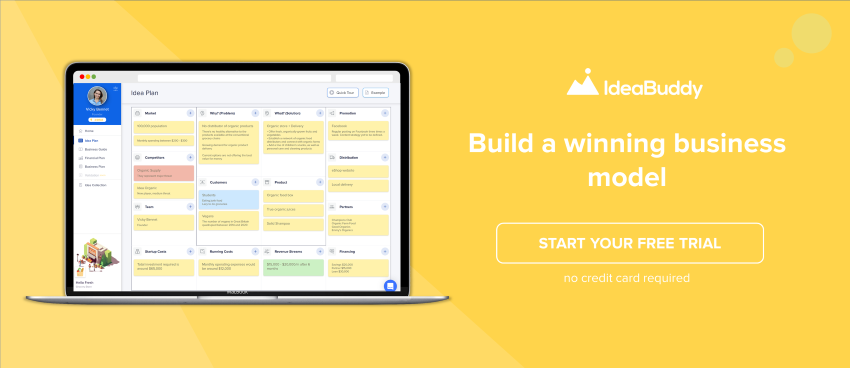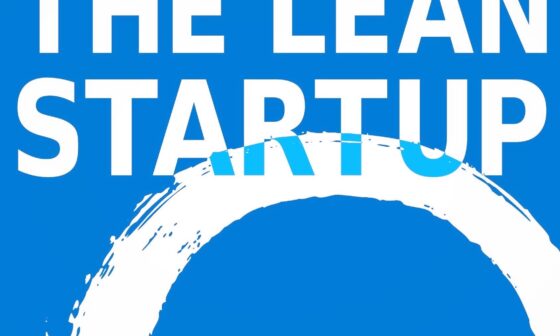Today, we wanted to walk you through the creation of a one-page business canvas by using Idea Plan. This way, you make the most out of Idea Plan capabilities and sense-check your business idea in its infancy. And given the flexible nature of Idea Plan, you can explore any gray areas in real-time and build a feasible business model in no time.
Idea Plan – Getting started
Each industry is different, which means that the steps of building a business model will be unique for each of them. Hence, the first step within Idea Plan is to select your idea from one of the categories. Also, where we’ve prepared lots of templates to help you develop your idea faster.

In this walkthrough, we wanted to provide specific guidance and bring more value to your own canvas creation with Idea Plan. So we’re going to show the full-scale capabilities of Idea Plan by creating a business canvas for Comfort Keepers, a fictional home repair shop that’s just entering an already saturated market. Their main product is an end-to-end app where people can order home repair services and lay back.
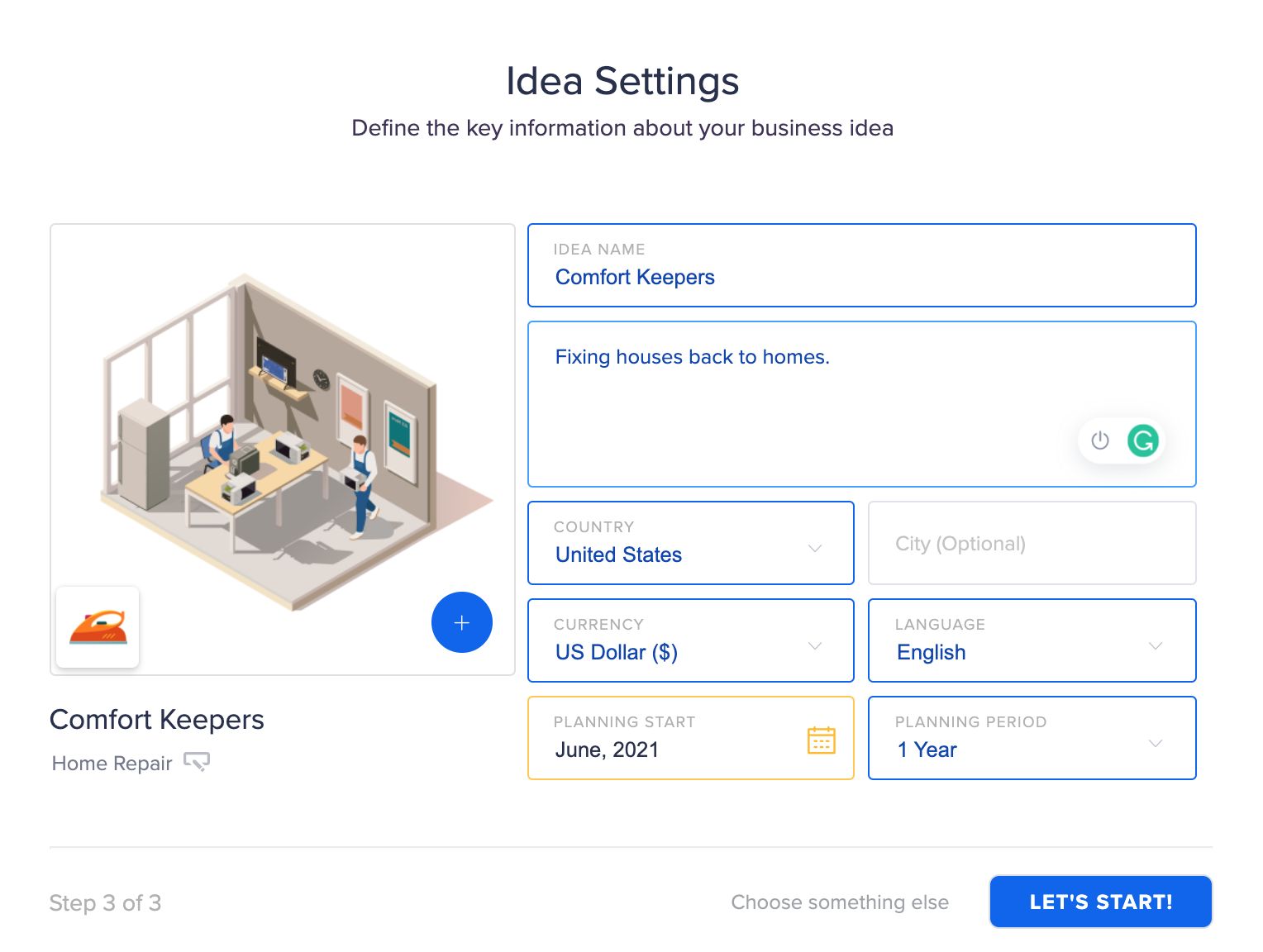
Building blocks of Idea Plan
Idea Plan might remind you of the traditional business model canvas but comes with a twist. In today’s market, it’s crucial to be nimble and agile. Companies need to provide maximum value to consumers at all times. A small shop such as Comfort Keepers competes with household names and lacks budget. So, it’s important to first dive deep into the essential, central four blocks and get them right.

Why? (Problem)
The first of these blocks is “Why?” i.e. the problem that Comfort Keepers are solving. In this part, it’s essential to answer the following questions:
- Is there a market problem that you plan to solve with your business idea?
- What unmet customer needs can be an opportunity for you?
For Comfort Keepers, the answer might look like this:
- Many homeowners need home repairs done but don’t want to purchase equipment, and home repair shops don’t offer small-scale repairments
- Customers are left agitated as their need to have some tiny home annoyances fixed has been ignored; they feel unappreciated and think that big home repair shops don’t care about them
What? (Solution)
The next block is the solution to the problem we’ve just identified. Just be careful here — often, founders start focusing on the features and capabilities, rather than on the value. But a lasting idea needs to focus on the solution to the problem. Only later will these translate to actual features that you will build over time.
For our home repair shop, the solution lies in providing personalized service and highly skilled workers. It’s about building partnerships and delivering the best customer experience to homeowners. This highly tailored home care helps Comfort Keepers stand apart from the laggard competition.
Customers
Now, Comfort Keepers need to focus on their customers. There are numerous methodologies to be applied here, from design thinking to customer discovery maps. Whichever of these you chose, think about the following two aspects:
- Who are your most important customers?
- What are their goals and pain points?
Business founders tend to plan far into the future. But this is often a trap; without initial investment and customer base, your business won’t get far.
Looking at Comfort Keepers, they need to stay agile and start getting traction. Comfort Keepers cannot afford to expand into several cities straight away. No, they have to prioritize their most important customers first, such as suburban families in a particular neighborhood they can easily serve, with the starting budget.
The pain points of this first group of customers could be a lack of tools and expertise to get tiny things done around the house.
Important to remember here is to not fall into the trap of over-engineering the initial customer discovery. Instead, focus on one key goal and pain point for your first two to three customers and deliver on it.
Product
In the final central block — Product, you need to focus on the value you deliver to the client and how it differs from the rest.
For our small home repair shop, the answer would like this:
“We offer highly-personalized, skilled workers, who take care of home repairs but behave as part of the family and provide guidance to homeowners. Whereas most home repair chains focus on margins and quantity, we focus on delivering outstanding customer service, with excellent availability of home repair services.”
Here’s a look at our Comfort Keepers business canvas now that we have filled out the essential blocks:
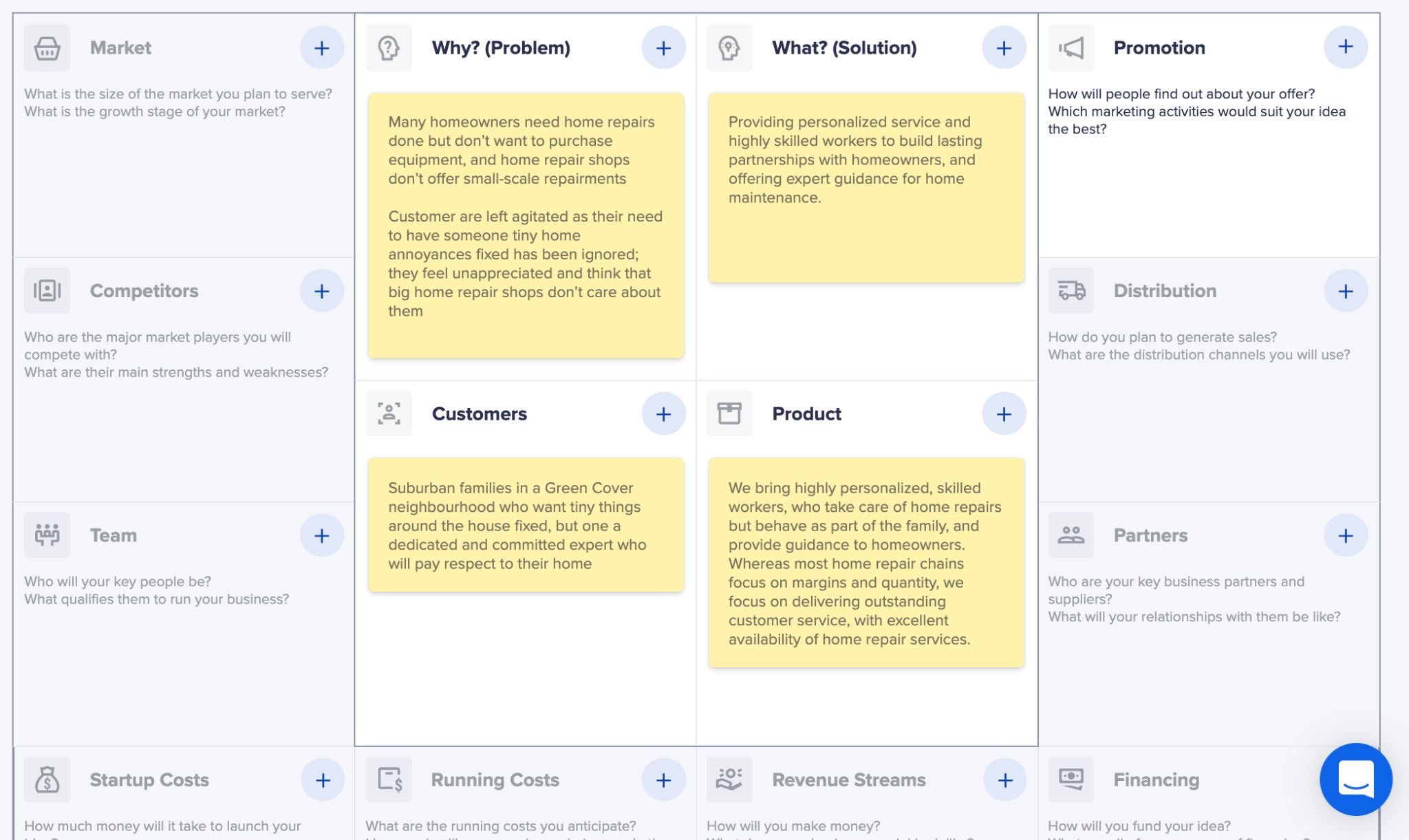
While these four central blocks suffice as a starting point, you can better check the overall feasibility of your ideas if you fill out all the other blocks as well.
So let’s start with the left-hand side of your Idea Plan canvas and focus on the market, competitors, and team.
Market
When sketching out the Market square, you should focus on two essential questions:
- The size of the market you plan to serve
- The growth stage of your market
Getting these right is important as it determines your market entering strategy and how to remove any barriers to entry. Again, to get the most of your canvas, focus on the cues within Idea Plan — they are formulated to help you stay agile and adapt fast.
For Comfort Keepers, our market definition could look like this:
“We want to serve the local city market with the Green Bay area and a population of 120,000 people.
Our market is saturated with big home repair chains, but very few personalized home repair startups.”
Competitors
Within competitors, you want to focus on two to three biggest companies that serve your niche. Work on their strengths and weaknesses, especially where there is a direct overlap with your offering.
For example, Comfort Keepers compete with “two big home repair shops, each with multiple, easily accessible locations, and versatile product offering. They also compete against a small mom and pop home repair shop that’s been in the market for years and has a loyal customer base, but lacks any digital offerings.”
Team
Here you focus on key people and their qualities to run your business. This is a good signal for investors and customers alike — the more relevant experience you have, the easier it will be for your pitch to be trustworthy.
In Comfort Keepers, there is Mr. Green, who has led maintenance departments in large stores for 25 years and knows the market well. There is also Ms. Blue who has founded three startups and led digital information in large tech companies in Green Bay.
Combined, their experience helps cover the traditional home repair services and innovation.
Alright, here is our Idea Plan Canvas at the moment:

Next, we focus on promotion, distribution and partners.
Promotion
As part of promotion defining, we want to focus on two things:
- How will people find out about your offer?
- Which marketing activities would suit your idea the best?
The answers to these questions are closely related to your customer definition.
For Comfort Keepers, we ought to know whether the denizens in the Green Bay area use digital technologies or not. Which channels? Will you advertise the launch of your new mobile app through email and paid ads? Will there be physical flyers? Are you going to produce organic content, such as video tutorials?
Distribution
Within distribution, we need to focus on:
- How do you plan to generate sales?
- What are the distribution channels you will use?
Again, it’s key to keep this realistic, especially when you focus on the initial stages. Budget constraints will determine your distribution channels, so keep it feasible. Comfort Keepers will focus first on their app where people can book home repairs, and only later on their webshop.
Partners
Having a business that lasts requires good partners. So here you determine your key suppliers and strategic partners and how you plan to work together.
Comfort Keepers work with electricians, plumbers, gardeners and a vast variety of handypeople, and help them earn money on the side. Meanwhile, Comfort Keepers also take a small fee as a commission.
Plus, to provide full service to homeowners, Comfort Keepers also work with local home supply stores.
Here is a quick look at our Idea Plan canvas at the moment:

Financial blocks
Finally, we turn to financial blocks to look at how we’re going to fund all the investments we had in mind.
Startup costs
Here, you need to identify how much money it will take to launch your idea, and which startup expenses you need to cover.
For Comfort Keepers, we need to cover the following initial expenses:
- App developers and designers
- Ads in newspapers for the initial buzz
- Content creators
- Pay legal to draw up contracts with supplies and local shops
Rough estimate – $50,000
Running costs
Running costs are more regular, recurring costs you will need to pay once your idea takes off.
Here, you need to define the running costs you anticipate, as well as costs for salaries, marketing, and other overhead, such as space rental, fees covering, etc.
Revenue streams
This is the place to dive into the business model and work out the details of your business. Here you need to figure out how you will make money and what your revenue streams will be.
At Comfort Keepers, we earn money by connecting handypeople with homeowners, and taking a part of the earnings as a commission. Customers are guaranteed the lowest prices in the market and we always price match. We offer various payment models, from one-off repairs to life-time service, and we also work not only with B2C clients (homeowners) but also plan to offer services to local shops that need repairs.
Financing
Finally, when you have all the other steps figured out, it’s time to focus on funding your idea. You need to determine what sources of funding you will be using, who will be providing the finances, how you plan to scale and secure the funds.
Comfort Keepers will secure initial funding from the local GreenBay fund and will be part of the launchpad incubator for additional financing. In addition, the startup will pair up with local unions of workers and take no fees from handypeople during the first year.
Now that we have covered all the steps, here is what our Idea Plan looks like:
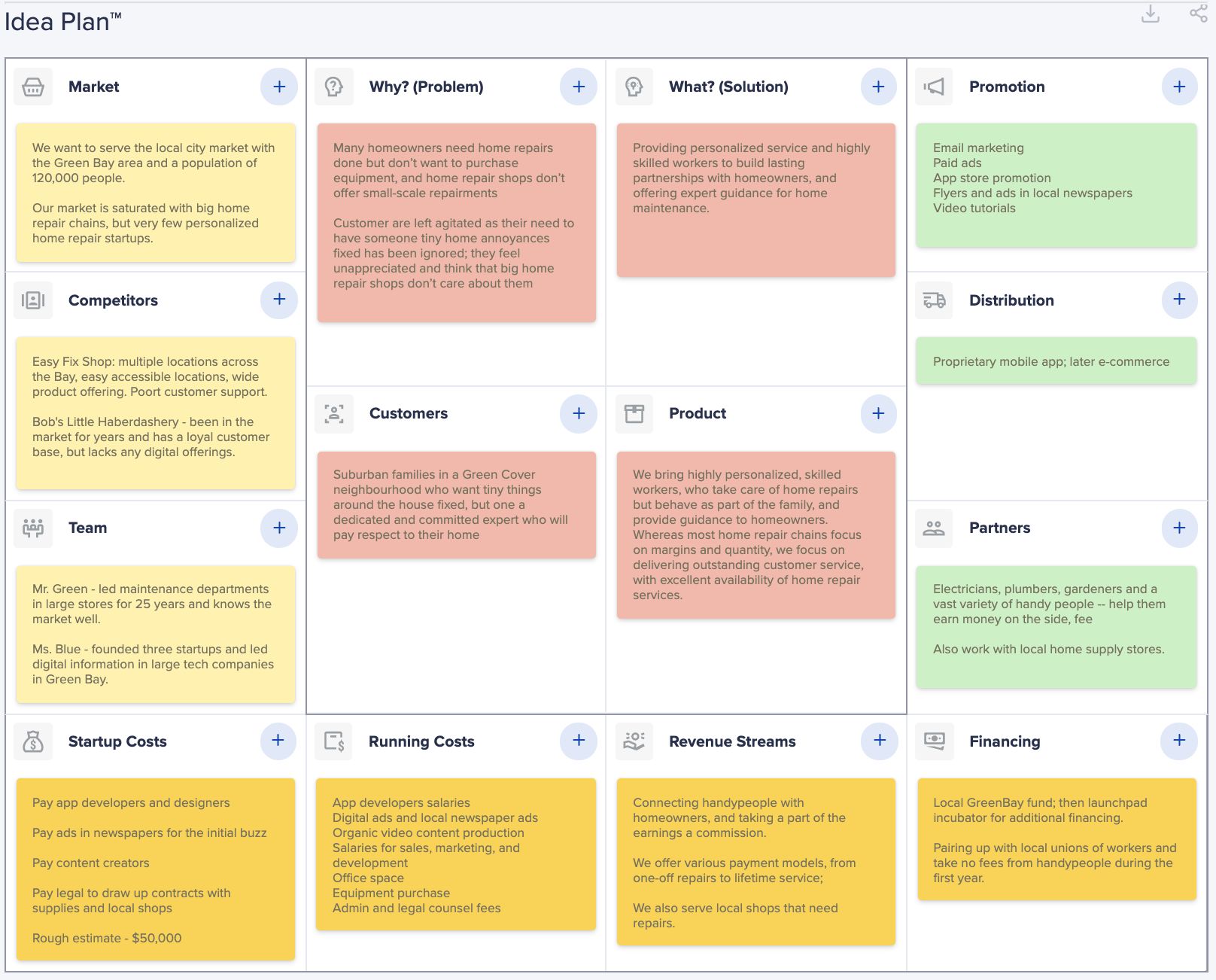
Idea Plan business canvas: Summary
While our canvas could use more fine-tuning, it’s a simple and easy way to help assess priorities and business idea feasibility in under an hour.
Ready to start fleshing out your business canvas? Try Idea Plan and start building your business right away!

